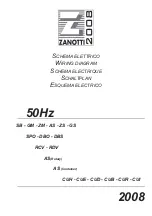
Reach-In Refrigerator Installation Manual
Publication Number: 630460252INS
- 6 -
© 2004, IMI Cornelius Inc.
R
ELEASE
THE
C
OMPRESSOR
T
IE
-
DOWN
B
OLTS
Check the compressor compartment to see if your cabinet has a spring-mounted compressor which is
bolted down to avoid shipping damage. Loosen the tie-down nuts until the compressor is loose and rides
free on the springs.
WARNING
- Failure to loosen these bolts will result in excess noise and vibration which will
damage the refrigeration system and void your warranty.
C
ONNECT
THE
C
ABINET
TO
A
P
ROPER
E
LECTRICAL
P
OWER
S
UPPLY
Be sure that a qualified electrician or refrigeration service person checks to see that your building’s wire
size is adequate to carry the load of the cabinet being installed and the circuit breaker or fuse is a time-
delay type. Each refrigerator should be connected to its own circuit for best operation and to avoid
possible product loss due to other defective electrical appliances. The cabinet comes with an on/off
power switch located in the unit compartment in compliance with U.L. requirements. Consult the
specification sheet and wiring diagram for details about your model cabinet. Consult the local electrical
codes and U.L. for additional requirements. A 5% deviation from the specified electrical requirements will
result in poor performance, shorten the life of the electrical components, and void your warranty.
Plug in your cabinet
If your cabinet is rated at 12 amps or below, a standard three-prong grounding power plug is provided. Be
sure to plug directly into a properly-grounded three-prong receptacle.
If your cabinet is rated at 13 amps to 15 amps, a special three-prong grounding power plug is provided.
Be sure to plug directly into a properly-grounded three-prong receptacle.
IMPORTANT - Do not, under any circumstances, cut or remove the round grounding prong from the
power plug.
If your cabinet is rated at 16 amps or above, an electrician must run the proper size wiring to the
power box.
See the enclosed electrical diagram for details.
FIGURE 8
FIGURE 9






























